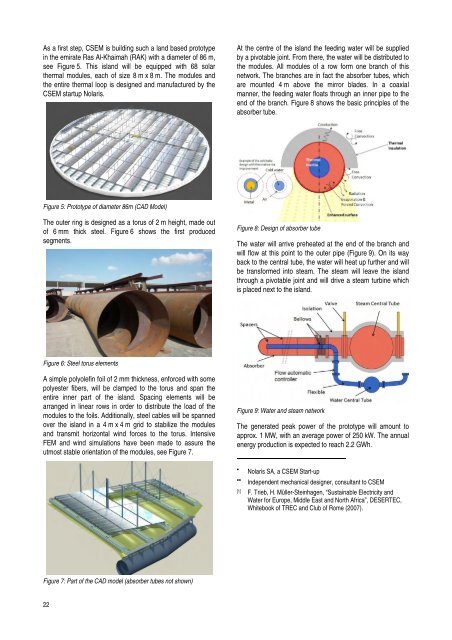research activities in 2007 - CSEM
research activities in 2007 - CSEM
research activities in 2007 - CSEM
Create successful ePaper yourself
Turn your PDF publications into a flip-book with our unique Google optimized e-Paper software.
As a first step, <strong>CSEM</strong> is build<strong>in</strong>g such a land based prototype<br />
<strong>in</strong> the emirate Ras Al-Khaimah (RAK) with a diameter of 86 m,<br />
see Figure 5. This island will be equipped with 68 solar<br />
thermal modules, each of size 8 m x 8 m. The modules and<br />
the entire thermal loop is designed and manufactured by the<br />
<strong>CSEM</strong> startup Nolaris.<br />
Figure 5: Prototype of diameter 86m (CAD Model)<br />
The outer r<strong>in</strong>g is designed as a torus of 2 m height, made out<br />
of 6 mm thick steel. Figure 6 shows the first produced<br />
segments.<br />
Figure 6: Steel torus elements<br />
A simple polyolef<strong>in</strong> foil of 2 mm thickness, enforced with some<br />
polyester fibers, will be clamped to the torus and span the<br />
entire <strong>in</strong>ner part of the island. Spac<strong>in</strong>g elements will be<br />
arranged <strong>in</strong> l<strong>in</strong>ear rows <strong>in</strong> order to distribute the load of the<br />
modules to the foils. Additionally, steel cables will be spanned<br />
over the island <strong>in</strong> a 4 m x 4 m grid to stabilize the modules<br />
and transmit horizontal w<strong>in</strong>d forces to the torus. Intensive<br />
FEM and w<strong>in</strong>d simulations have been made to assure the<br />
utmost stable orientation of the modules, see Figure 7.<br />
Figure 7: Part of the CAD model (absorber tubes not shown)<br />
22<br />
At the centre of the island the feed<strong>in</strong>g water will be supplied<br />
by a pivotable jo<strong>in</strong>t. From there, the water will be distributed to<br />
the modules. All modules of a row form one branch of this<br />
network. The branches are <strong>in</strong> fact the absorber tubes, which<br />
are mounted 4 m above the mirror blades. In a coaxial<br />
manner, the feed<strong>in</strong>g water floats through an <strong>in</strong>ner pipe to the<br />
end of the branch. Figure 8 shows the basic pr<strong>in</strong>ciples of the<br />
absorber tube.<br />
Figure 8: Design of absorber tube<br />
The water will arrive preheated at the end of the branch and<br />
will flow at this po<strong>in</strong>t to the outer pipe (Figure 9). On its way<br />
back to the central tube, the water will heat up further and will<br />
be transformed <strong>in</strong>to steam. The steam will leave the island<br />
through a pivotable jo<strong>in</strong>t and will drive a steam turb<strong>in</strong>e which<br />
is placed next to the island.<br />
Figure 9: Water and steam network<br />
The generated peak power of the prototype will amount to<br />
approx. 1 MW, with an average power of 250 kW. The annual<br />
energy production is expected to reach 2.2 GWh.<br />
•<br />
Nolaris SA, a <strong>CSEM</strong> Start-up<br />
••<br />
Independent mechanical designer, consultant to <strong>CSEM</strong><br />
[1] F. Trieb, H. Müller-Ste<strong>in</strong>hagen, “Susta<strong>in</strong>able Electricity and<br />
Water for Europe, Middle East and North Africa”, DESERTEC,<br />
Whitebook of TREC and Club of Rome (<strong>2007</strong>).








